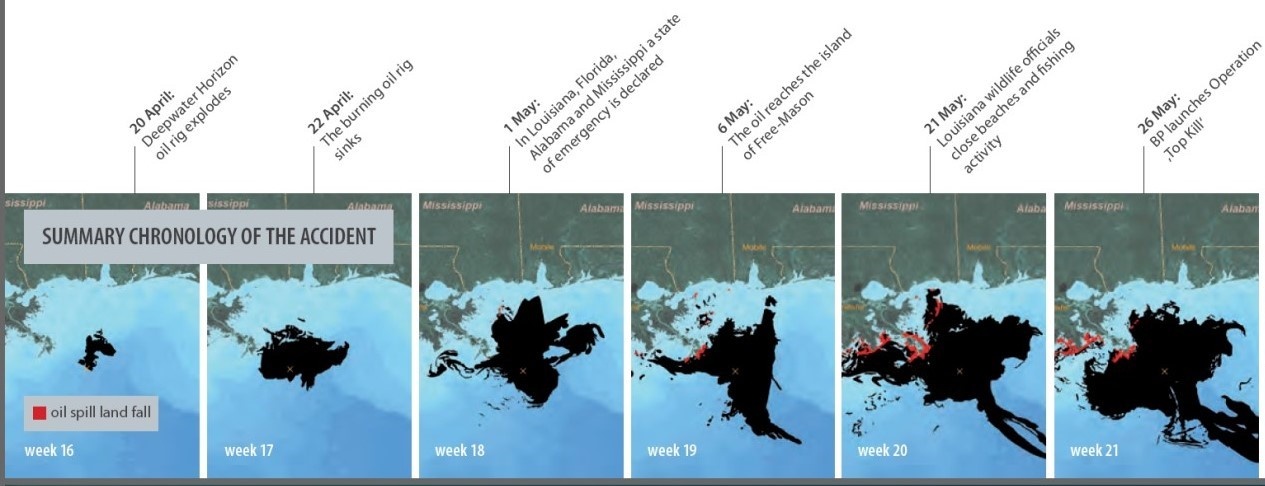The coupled approach of employing multi-source optical and radar satellite data (from various satellite systems) allowed for a timely, synoptic, consistent and precise mapping of the oil spill extent in the Gulf of Mexico. In particular radar satellite data were very suitable for the water surface oil slick mapping due to the strong absorbance of the radar signal by the oil slick. To derive a consistent chronology of the oil spill the custom mapping productions were combined with oil spill delineations made available through public identities to accumulate a complete database of the temporal oil slick coverages. These were analysed through a GIS to produce daily and weekly summary frequency maps depicting how often an area was covered by oil from the beginning to the end of the drilling hole opening. The accumulation of satellite-derived oil spill extents allowed identification and quantification of areas that have been affected hardest, on the ocean as well as on the coast (Figure 2). To determine the oil interaction within coastal habitats, the cumulative weekly maps were intersected with coastal land cover data classified into habitats of particular interest. In this way, the length of the shoreline affected by the oil spill was identified for each land cover class, indicating also the frequency of oil contact. The resulting GIS database provided the basis for statistical analyses that were carried out for the affected shorelines in Louisiana, Mississippi, Alabama and western Florida. Sea turtle nesting sites and Atlantic Bluefin Tuna (ABFT) habitat spawning index grids were intersected with the cumulative weekly oil spill maps to identify affected sites of this marine species of particular interest. 
Figure 2: Summary chronology of the oil spill for 20 April to 26 May 2010 Coastal land cover mapping: To determine the oil interaction within coastal habitats, the cumulative weekly maps were intersected with NOAA Gulf Coast Land Cover data (http://www.csc.noaa.gov). This way, the length of the shoreline affected by the oil spill was identified for each land cover class, indicating also the frequency of oil contact. The resulting GIS database provided the basis for statistical analyses that were carried out for the affected shorelines in Louisiana, Mississippi, Alabama and western Florida (Escambia, Okaloosa, Walton, Santa Rosa, Bay, Gulf). Atlantic Bluefin Tuna (ABFT) spawning habitat monitoring: Atlantic Bluefin Tuna (ABFT) spawning stock in the western Atlantic has declined by >90% over the past 30 years. One of the management and conservation issues facing ABFT is the need to protect spawning grounds. To document the interaction of the oil spill with the ABFT spawning habitat, the ABFT spawning index was simulated and intersected with the evolution of the oil spill. Spawning habitat index (values from 0 – 1) is the measure of how favourable local environmental conditions [temperature, presence of food and absence of predators of larvae] are for the spawning of the species. Sea Turtle nesting habitat monitoring: Sea turtle nesting sites obtained from the State of the World`s Sea Turtles (SWOT) database (http://seaturtlestatus.org/) were intersected with the cumulative weekly maps to identify affected sites. Eroded nesting beaches are a major threat to sea turtle populations, together with destroyed foraging habitats and both chemical and physical effects from contact. Major oil spills affect sea turtles at all life stages and nearly all turtles coming in contact with an oil spill will die or become severely debilitated.
|